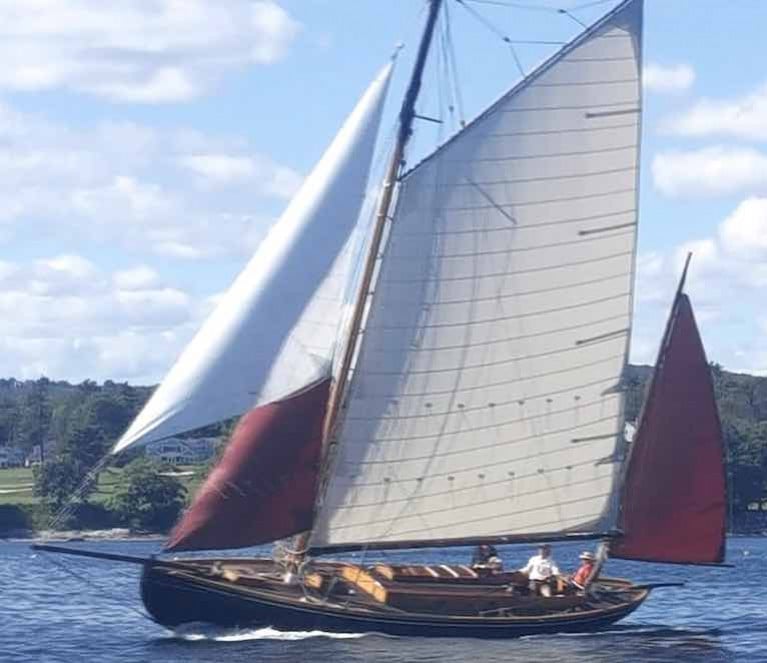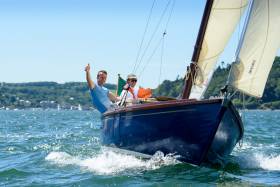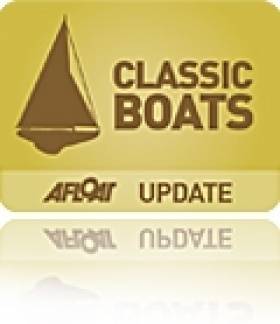Displaying items by tag: traditional boats
Dubliner Paul Keogh Receives Top Honour For Voluntary Work With Community Project in Traditional Boats
The saga of the building and sailing of the traditional Galway Hooker Naomh Cronan by Clondalkin Community in west Dublin goes back nearly thirty years. And though the story has regularly featured in Afloat.ie,
the various lockdowns had made it difficult to properly mark the end of a special era at Poolbeg Yacht & Boat Club in Dublin Port when Naomh Cronan was moved west to Galway Bay.
But with normality returning, back in January this year it was announced the international Old Gaffers Association had recognised the outstanding contribution made by Paul Keogh over many years in keeping
the Naomh Cronan ideal alive and active and sailing, until the time had arrived for the boat to be transferred to the traditional boat group in Galway City.
 Naomh Cronan, the successful outcome of a very special Clondalkin community project. Photo: W M Nixon
Naomh Cronan, the successful outcome of a very special Clondalkin community project. Photo: W M Nixon
The OGA's supreme award for contributions to traditional and classic sailing is the Jolie Brise Cup, named in honour of the most famous gaff cutter in the world, the pilot cutter Jolie Brise built by Paumelle of Le Havre in 1913. Jolie Brise's working career was brief, as she was superseded during World War I of 1914-18 by steam and diesel-driven craft. But she then switched to a successful career - which still continues - as an offshore racer, long-distance voyager, and sail training ship of global renown, and the linking of Paul Keogh and the Naomh Cronan with this remarkable craft is a well-earned recognition of a very special effort.
OGA President Patrick Vyvyan-Robinson came to Dublin for the presentation to Paul Keogh, and in recognition of Dublin Port's special relationship with the traditional boat movement, which will be further celebrated next year when the Old Gaffers Association's 60th Anniversary Cruise-in-Company features a Dublin visit.
 Jolie Brise - the most famous gaff cutter in the world gives her name to the OGA's premier award
Jolie Brise - the most famous gaff cutter in the world gives her name to the OGA's premier award
Ireland's Classic & Traditional Boats Give Us Hope in Challenging Times
In this time of increasing uncertainty with its frustration of sailing plans, we find reassurance in soothing thoughts of well-restored or new-built classic boats. And traditional vessels in handsome and workmanlike order have the same heartening effect. We've an instinct for properly-used and sensibly-deployed timber in our DNA, for in prehistoric times, it was a significant survival asset. Now, it reminds us of the need for patience, and we find comfort in clichés, not least in the old chestnut that when God made time, he made a lot of it.
For time can be a matter of the greatest importance with the restoration of classics. This month, John Kearney's great Mavis – built in Ringsend in Dublin in 1923-25 - is sailing again in Maine, after a restoration which has lasted very many years. And in so doing, she and those who have brought her back to life remind us of how much has been achieved in recent times to preserve and restore Ireland's historical boats. Perhaps most encouragingly of all, they've been restored not as lifeless museum pieces, but rather as vigorous members of the nation's active fleet, providing inspiring sailing and some excellent racing sport.
 Mavis as she will be when her sails have become a complete suit. It is 1928, Mavis has been completed for three years, and she is seen here with Skipper Kearney in full command, sweeping into the finish before an appreciative audience to win Skerries Regatta. For twenty-five years, Skipper Kearney and Mavis were regarded as star turns on Ireland's East Coast, with a formidable record in both inshore and offshore racing. Photo: Courtesy Ronan Beirne
Mavis as she will be when her sails have become a complete suit. It is 1928, Mavis has been completed for three years, and she is seen here with Skipper Kearney in full command, sweeping into the finish before an appreciative audience to win Skerries Regatta. For twenty-five years, Skipper Kearney and Mavis were regarded as star turns on Ireland's East Coast, with a formidable record in both inshore and offshore racing. Photo: Courtesy Ronan Beirne
But before we delve into the new life which is being found for wooden one-design classes and other special vessels of very varying vintages, we must pay our respects to John B Kearney, and to Ron Hawkins and Denise Pukas and their friends and helpers in Camden in Maine, who have patiently brought Mavis back to life. They've progressed the work as time and resources become available, for Ron is a master shipwright from a noted maritime family, and his skills are much in demand by others.
In its Dublin way, John B Kearney's Ringsend background superficially seems not to have been so very different, yet his was a life which would have been remarkable by any standards, in any place, at any time. For in the Dublin of its era, this was a life of astonishing achievement against all the odds in a rigidly structured society made even more conservative by a time of global unrest and national upheaval.
Yet here was a largely self-taught young many who was to design many boats – including the Dublin Bay Mermaid in 1932 – who quietly yet steadily progressed with his zest for life undimmed – he was still designing boats in his eighties – while the respect he received in the sailing world was such that he was a Flag Officer of the National Yacht Club in Dun Laoghaire – for he had long since moved from Dublin city to Monkstown – for the last 20 years of his life.
 The eternal enthusiast. John B Kearney, aged 83, at work in 1963 on the plans of his largest yacht, the 53ft Tyrrell of Arklow-built Helen of Howth
The eternal enthusiast. John B Kearney, aged 83, at work in 1963 on the plans of his largest yacht, the 53ft Tyrrell of Arklow-built Helen of Howth
John Breslin Kearney (1879-1967) was born of a longshore family in the heart of Ringsend in Dublin, the eldest of four sons in a small house in Thorncastle Street. The crowded old houses backed onto the foreshore along the River Dodder in a relationship with the muddy inlet which was so intimate that at times of exceptional tidal surges, any ground floor rooms were at risk of flooding.
But at four of the houses, it enabled the back yards to be extended to become the boatyards of Foley, Murphy, Kearney and Smith. Other houses on Thorncastle Street provided space for riverside sail lofts, marine blacksmith workshops, traditional ropeworks, and all the other long-established specialist trades which served the needs of fishing boats, and the small vessels - rowed and sailed - with which the hobblers raced out into Dublin Bay and beyond to provide pilotage services for incoming ships.
And increasingly, as Dublin acquired a growing middle class with the burgeoning wealth of the long Victorian era, the little boatyards along the Dodder also looked after the needs of the boats of the new breed of recreational summer sailors.
The young John Kearney was particularly interested in this aspect of activity at his father's boatyard, where he worked during time away from school. From an early age, he developed a natural ability as a boat and yacht designer, absorbing correspondence courses and testing his skills from 1897 onwards, when he designed and built his first 15ft sailing dinghy, aged just 18.
In adult life, during the day he worked initially as a shipwright in Dublin Port & Docks, but his skills could be so broadly applied that he rose rapidly through the ranks to become involved in the work of many departments, such that by the time of his retiral in 1944, while he was officially the Superintendent of Construction Works, in reality, he was the Harbour Engineer, yet couldn't be so named as he had no university degree.
However, this lack of an official title left him unfazed, for his retirement at the age of 65 meant he could concentrate full-time on his parallel career as a yacht designer, something that was so important to him that when his gravestone was erected in Glasnevin in 1967, it simply stated: John Kearney, Yacht Designer.
 The Skipper – John Kearney, in the companionway of Mavis, keeps an eye on the making breeze in Dun Laoghaire on a Saturday afternoon in the summer of 1950. Photo: Richard Scott
The Skipper – John Kearney, in the companionway of Mavis, keeps an eye on the making breeze in Dun Laoghaire on a Saturday afternoon in the summer of 1950. Photo: Richard Scott
 Born again. The restored Mavis at anchor in Maine, September 2020. Photo: Denise Pukas
Born again. The restored Mavis at anchor in Maine, September 2020. Photo: Denise Pukas
That he was also a master boatbuilder who had been able to design and build fine yachts in his spare time isn't stated, but over the years he created many, and the 38ft Mavis for himself in 1925 was a masterpiece, with an astonishingly good performance which was such that after racing unsuccessfully against John Kearney and Mavis in a stormy offshore race in the Irish Sea in 1935, Humphrey Barton – who later founded the Ocean Cruising Club in 1954 - was moved to write an article for Yachting World drawing attention to this relatively unsung sailing star from Dublin Bay.
John Kearney's determination to be a full-time yacht designer after his retirement was such that in 1951 he sold Mavis to Paddy O'Keeffe of Bantry, as his yacht design clients expected him to sail part of each season in their new Kearney-designed boats and Mavis wasn't getting the use she deserved. She returned briefly to Dublin Bay in 1956 in the ownership of Desmond Slevin, a ship's doctor who was given a lucrative posting in the US, so he had Mavis shipped across the Atlantic, and she has been New England-based ever since.
She has been both lucky and unlucky in her time in America. Lucky in that there has always been someone who recognised that there was something special in this characterful boat that made her worth preserving. Yet unlucky in that it was never someone with the substantial resources to restore her completely to the classic yacht standards to which John Kearney has so skillfully and painstakingly built her, for such people put their wealth into recognised brands such as Herreshoff, Fife, Sparkman & Stephens, and John Alden.
 A lot done, and much more still to do. Ron Hawkins in the stripped-out hull of Mavis. Photo: Tim Magennis
A lot done, and much more still to do. Ron Hawkins in the stripped-out hull of Mavis. Photo: Tim Magennis
Yet the fates were kind in letting Ron Hawkins see the spark that might be found in Mavis, and many years ago he took her over with the intention restoring her as time and funds became available from his work as a master shipwright. It was bound to be a long time, as the rising enthusiasm for classic and traditional craft kept him busy - sometimes until late into the night - at the waterfront boatyards. But he moved Mavis to a workshop on the outskirts of town and started the long process of stripping her out and gradually bringing her back to John Kearney standards, with the supportive arrival of Denise Pukas boosting his enthusiasm for a quality project which at times looked like it might stretch into infinity.
 The restored Mavis, newly-launched in 2015, with Don O'Keeffe (nephew of Paddy O'Keeffe) on the tiller in the cockpit with Denise Pukas, and Ron Hawkins in the inflatable
The restored Mavis, newly-launched in 2015, with Don O'Keeffe (nephew of Paddy O'Keeffe) on the tiller in the cockpit with Denise Pukas, and Ron Hawkins in the inflatable
 The inevitable hiatus. Mavis awaiting her spars and sails
The inevitable hiatus. Mavis awaiting her spars and sails
Regular readers of Afloat.ie will know that the restored Mavis was finally put in the water in Camden in 2015. Yet with a boat and rig like this, much remained to be done, and always there were the demands of other income-generating projects. Thus it wasn't until the pandemic loomed over the horizon that boatyard work slackened, and there was an unexpected time in the Spring of 2020 to complete the mast and rigging, and get it stepped.
Even when doing it yourself to the extent – as Ron did – of personally making the gaff-boom leather saddle, it's still costly when you're doing it to top Kearney standards, as the best of materials are expected. And though we were receiving photos through the summer of the mast being stepped and dressed, the cryptic attached message said no more than: "Still waiting for the mainsail".
 In late summer 2020, the new mainsail finally arrived. Photo: Denise Pukas
In late summer 2020, the new mainsail finally arrived. Photo: Denise Pukas
Thus it seemed that the Mavis sailplan was being assembled from bits and pieces, whereas a full-blown high-budget project would rely for the final effect on a very complete sailplan, such as Mavis was showing in style at Skerries regatta in 1928.
Be that as it may, early in September, we received an untitled snap showing the mainsail finally in place, other photos arrived showing her taking her first tentative steps under main and jib, and then today's header photo arrived showing Mavis making effortless knots under a slightly eccentric rig derived from several sources, with a high-flying jib which in time may well become the jib topsail in the complete version.
When you've been undertaking a major restoration ashore and afloat with close personal involvement at every stage, it's quite a step from working to actually sailing, which is why in the traditional world there was a clear demarcation between builders and sailors. Thus it has taken a little while to become accustomed to the fact that the Mavis which everyone has known for years as something steady and secure in the workshop, or sitting serenely afloat in the Inner Harbor in Camden, is now a living thing which heels as her sails fill with power, and the sound of the sea chuckles past her easily-driven hull as she lifts to the waves.
But in that lovely Fall weather with which Maine is often blessed, they've been getting about, and a visit across to Eggemoggin Reach saw greetings from legendary photographer Benjamin Mendlowitz and a brief vid and immediate fame on his Instagram page. It tells us much about the easily-driven hull that John Kearney gave Mavis, as he gave her the most subtle set of lines with sweeping sheer and double curves in just about every direction to produce the boat that Humphrey Barton particularly recognised as being at one with the sea.
Benjamin Mendlowitz's glimpse of Mavis as published on Instagram
This elevation of the restored Mavis into a place in sailing's Hall of Fame is a timely reminder of the many other Irish projects – accelerating in number in recent years – which have paid the proper respect to Ireland's finest classic yachts and traditional boats by restoring them to full seagoing strength.
It's now a long time since Nick Massey began the restoration of the Howth 17s in 1972, a baton since taken up by Ian Malcolm, while across in Dun Laoghaire Hal Sisk was into an early episode of what has now become an epic tale beginning with the tiny Fife cutter Vagrant of 1884 – he restored her for her Centenary in 1984 – while also being involved with reviving the Water Wags, raising the profile of the Bantry Boat, restoring the 1894 Watson 36-footer Peggy Bawn with Michael Kennedy of Dunmore East for international stardom in 2005, and most recently bringing the Dublin Bay 21s back to life with the hugely-talented Steve Morris of Kilrush, a project also involving Dan Mill.
 Hal Sisk's 1894-built Peggy Bawn – seen here sailing at Glandore Classics - set a new standard for authentic restoration in 2005
Hal Sisk's 1894-built Peggy Bawn – seen here sailing at Glandore Classics - set a new standard for authentic restoration in 2005
Other groups had already taken on the very major project of a new life for the Dublin Bay 24s, and while it was a complex scheme which proved painful for some, the innate quality of the original Alfred Mylne design has shone through. Periwinkle is now in pristine restored condition in Dun Laoghaire, Zephyra is nearing re-completion at the ApprenticeShop in Maine (where they're also building a Water Wag), and Arandora is entering a re-build project in St Nazaire where Mike Newmeyer of Skol ar Mor has been commissioned to create a new boat-building school.
But we don't have to go abroad for classic boat-building skills, as Dougal McMahon of Athlone has taken on the mantle of the late Jimmy Furey – legendary builder of Shannon One Designs – and is currently restoring the 1930-built Water Wag Shindilla, a boat with long links to the Falkiner and Collen families, while down in West Cork Rui Ferreira has shown himself on top of the job in building in clinker for the Castlehaven Ette class, the International 12s, and the Water Wags, while being equally adept in putting a new teak deck on the Howth 17 Deilginis.
 Thriving in various forms since their foundation in 1887, the Dublin Bay Water Wags currently number 50 registered boats in racing condition
Thriving in various forms since their foundation in 1887, the Dublin Bay Water Wags currently number 50 registered boats in racing condition
Nearby, Tiernan Roe has taken on a variety of skilled work and is currently linked to the re-build of the O'Keeffe family's Lady Min (designed and built by Maurice O'Keeffe of Schull in 1902), while round the corner in Oldcourt on the Ilen River above Baltimore, Liam Hegarty is the sure and steady presence who restored the Ilen herself through a time-scale which rivals the re-birth of Mavis, and while as ever he's distracted by urgent work needing doing on fishing boats, the re-build of Conor O'Brien's Saoirse is proceeding steadily in the Top Shed with the hull caulked and the spars currently being made.
 Irish craftsmanship sails the Arctic….the Baltimore-built Trading Ketch Ilen of Limerick in Greenland, July 2019. Photo: Gary Mac Mahon
Irish craftsmanship sails the Arctic….the Baltimore-built Trading Ketch Ilen of Limerick in Greenland, July 2019. Photo: Gary Mac Mahon
 The distinctive shape of Conor O'Brien's world-girdling Saoirse continues to re-emerge at Oldcourt in West Cork, as seen yesterday (September 18th). The poop deck and the familiar main deck and coachroof are taking shape, while the hull has already been caulked. Photo: Paddy Hegarty
The distinctive shape of Conor O'Brien's world-girdling Saoirse continues to re-emerge at Oldcourt in West Cork, as seen yesterday (September 18th). The poop deck and the familiar main deck and coachroof are taking shape, while the hull has already been caulked. Photo: Paddy Hegarty
Along the south coast beyond Kinsale in Nohoval is Cork Harbour sailing's best-kept secret, Walsh Boat Works, where Jim Walsh creates classic finishes to Chippendale standards for quality craft such as Pat Murphy's charming Colleen 23 Pinkeen and the International Dragon Fafner. The latter is currently on the market for anyone seeking a top entry boat to join that special group of classic Dragons in Glandore which, back in July, helped the great Don Street celebrate his 90th birthday.
 How about that then? The immaculate deck of the restored classic Dragon Fafner as she emerged from Walsh Boatworks of Nohoval. Photo Dan O'Connell
How about that then? The immaculate deck of the restored classic Dragon Fafner as she emerged from Walsh Boatworks of Nohoval. Photo Dan O'Connell
Jim Walsh is also making input into another significant Cork harbour yacht restoration which will see the light of day in due course, but meanwhile, his involvement with Dragons is a reminder that the interest in restoring them is reflected up north, where a secret workshop near Ballyhornan beside the entrance to Strangford Lough has seen the Dragon Skeia superbly restored, and they're now working on a very special bit of Irish Dragon history, the late great Jock Workman's Dalchoolin which is being restored to former glory after her hull and keel were retrieved from two different locations.
 You wouldn't expect to find worthwhile restoration projects in a shiny showroom – this is the legendary International Dragon Class Dalchoolin being unearthed in multi-purpose premises on the Ards Peninsula in County Down. Photo: James Nixon
You wouldn't expect to find worthwhile restoration projects in a shiny showroom – this is the legendary International Dragon Class Dalchoolin being unearthed in multi-purpose premises on the Ards Peninsula in County Down. Photo: James Nixon
 On closer examination, Dalchoolin proved to be eminently restorable, and the work is now under way. Photo: James Nixon
On closer examination, Dalchoolin proved to be eminently restorable, and the work is now under way. Photo: James Nixon
This leap from Cork Harbour to Strangford Lough seems to leave the East Coast and Dublin in particular devoid of the classic skills, but they're there in Arklow if you know whom to seek, while in Dublin, there's Larry Archer's impressive record in restoring boats with Ian Malcolm of the Howth 17s and the Water Wags, particularly impressive in that Larry can somehow find a flicker of life in a very damaged boat which others might have been too ready to write off as a total loss, while in Howth Johnny Leonard worked wonders in bringing the Bourke family's L Class Iduna back to better-than-new condition.
 The L Class Iduna's restoration by Johnny Leonard created a little classic glowing with health. Photo: W M Nixon
The L Class Iduna's restoration by Johnny Leonard created a little classic glowing with health. Photo: W M Nixon
As for traditional craft, the great Clondalkin-built Galway Hooker Naomh Cronan need skilled work done before she was moved to her new home in Galway city, and the job was done in style in Malahide by Donal Greene whose credentials are unrivalled, as he's from Connemara, he's descended in a long line from natural boatbuilders whose skills he manifests, and yet he has an enviable affinity for working with computers when planning how best to utilise the available amount of timber for a specific job.
 Guy & Jackie Kilroy's Marguerite, a Herbert Boyd design built in Malahide in 1896, is a restoration by Larry Archer
Guy & Jackie Kilroy's Marguerite, a Herbert Boyd design built in Malahide in 1896, is a restoration by Larry Archer
We seem to have a come a long and meandering way, travelling from the first sail in decades by John Kearney's Mavis in her new Maine home, to the skills of Larry Archer and others in putting vigorous new life into classic old boats here in Ireland. But the message is that the skills are available, the enthusiasm is there, and when the current pall over all our lives is lifted, the fleet will be there and ready to sail.
Baltimore’s the Place for the Best in Traditional Wooden Boats & the Great Folk Who Sail Them
West Cork is as much a state of mind as it is a place writes W M Nixon. And when you’re in its bright and cheerfully breezy sailor’s capital of Baltimore, the annual Maytime Festival of Wooden Boats is something very special. Last weekend, they gathered from near and far for a diverse programme afloat, mixed with everything from Boat Building Competitions and Craftwork Shows to Art Exhibitions ashore. It was quite a party, and we’ll let the photos speak for themselves. That said, where on earth did one of the Cork currachs get the name of “Magic Brat”…?
 Saoirse Muirreann, Lobsterboat, Cormac Levis, followed by An Rún, Mackerel Boat, owner Nigel Towse, skipper Ian Wright. Photo: Robbie Murphy
Saoirse Muirreann, Lobsterboat, Cormac Levis, followed by An Rún, Mackerel Boat, owner Nigel Towse, skipper Ian Wright. Photo: Robbie Murphy Saoirse Muirreann, Lobsterboat, Cormac Levis with Hanora, Lobsterboat, Nigel Towse, in background off Sherkin Island. Photo: Robbie Murphy
Saoirse Muirreann, Lobsterboat, Cormac Levis with Hanora, Lobsterboat, Nigel Towse, in background off Sherkin Island. Photo: Robbie Murphy
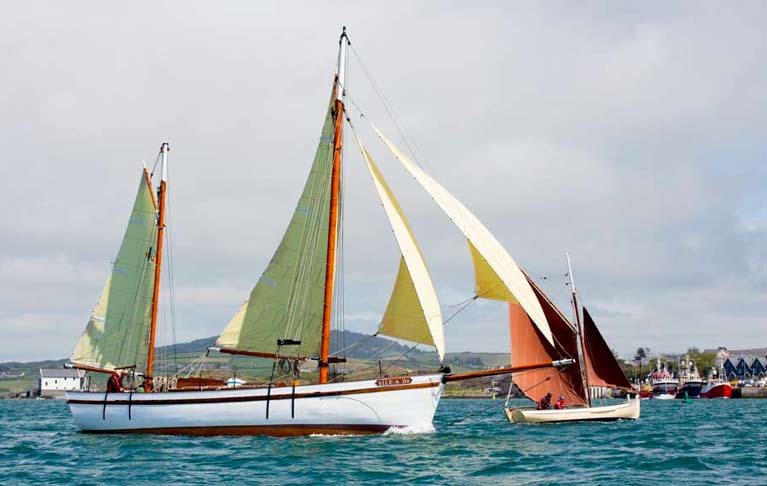 Sile a Do, gaff ketch built Hegarty’s, owner Leo McDermott (left) with Saoirse Muirreann (Lobster Boat, Cormac Levis) Photo: Robbie Murphy
Sile a Do, gaff ketch built Hegarty’s, owner Leo McDermott (left) with Saoirse Muirreann (Lobster Boat, Cormac Levis) Photo: Robbie Murphy Guillemot, built Skinners, Baltimore, 1893, Brian Marten. Photo: Robbie Murphy
Guillemot, built Skinners, Baltimore, 1893, Brian Marten. Photo: Robbie Murphy
 Fionn, Lobsterboat, skipper Rob O’Leary, and Lively, designed, built and skippered by James Baker of Penryn, Falmouth, Cornwall. Photo: Robbie Murphy
Fionn, Lobsterboat, skipper Rob O’Leary, and Lively, designed, built and skippered by James Baker of Penryn, Falmouth, Cornwall. Photo: Robbie Murphy Canóg, built by late George Bushe 1997, skipper Mark Bush, with Galway Hooker An Faoilean, Pat Tanner, built 1912. Photo: Robbie Murphy
Canóg, built by late George Bushe 1997, skipper Mark Bush, with Galway Hooker An Faoilean, Pat Tanner, built 1912. Photo: Robbie Murphy
 Pilot Race, with Rogaire Dubh Currach putting pilot onboard Lively for race back into Baltimore (winner of the Pilot Race) Photo: Robbie Murphy
Pilot Race, with Rogaire Dubh Currach putting pilot onboard Lively for race back into Baltimore (winner of the Pilot Race) Photo: Robbie Murphy
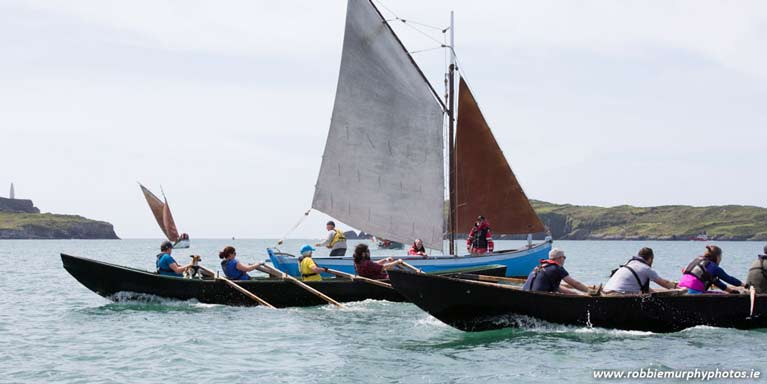 Racing Maitheal Mara Naomhogs with the blue-hulled Mary Colette Lobsterboat, Micheal O Croalaoi & John Colleran, An Rún Mackerel Boat, owner Nigel Towse, skipper Ian Wright in distant left. Photo: Robbie Murphy
Racing Maitheal Mara Naomhogs with the blue-hulled Mary Colette Lobsterboat, Micheal O Croalaoi & John Colleran, An Rún Mackerel Boat, owner Nigel Towse, skipper Ian Wright in distant left. Photo: Robbie Murphy
 Currach and Naomhogs racing for Baltimore, after rowing from Skibbereen down the Ilen River. Photo: Robbie Murphy
Currach and Naomhogs racing for Baltimore, after rowing from Skibbereen down the Ilen River. Photo: Robbie Murphy
 Fionn, Lobsterboat, built in Hegarty’s 1999, first of new-build Lobsterboats, owner Mary Jordan and the late Colm O Cuilleanain, sailed Rob O’Leary, Oisin Creagh Photo: Martyn Blair
Fionn, Lobsterboat, built in Hegarty’s 1999, first of new-build Lobsterboats, owner Mary Jordan and the late Colm O Cuilleanain, sailed Rob O’Leary, Oisin Creagh Photo: Martyn Blair
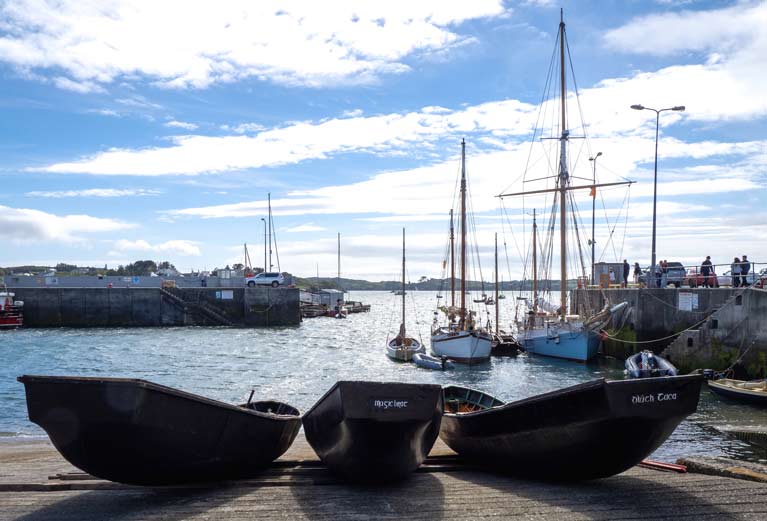 After the racing, currachs Rinceoir na Greine, Magic Brat and Dlúth Taca on slip, with Sile a Dó, An Faoilean and AK Ilen at the pier. Photo: Martyn Blair
After the racing, currachs Rinceoir na Greine, Magic Brat and Dlúth Taca on slip, with Sile a Dó, An Faoilean and AK Ilen at the pier. Photo: Martyn Blair
 Around the mark under the Beacon, Lively, James & Kate Baker (and their two children) followed by Mary Colette, Lobsterboat, Micheal O Croalaoi & John Colleran, Hanora, original Lobsterboat, Nigel Towse, and Fionn (Lobsterboat) in the distance. Photo: Martyn Blair
Around the mark under the Beacon, Lively, James & Kate Baker (and their two children) followed by Mary Colette, Lobsterboat, Micheal O Croalaoi & John Colleran, Hanora, original Lobsterboat, Nigel Towse, and Fionn (Lobsterboat) in the distance. Photo: Martyn Blair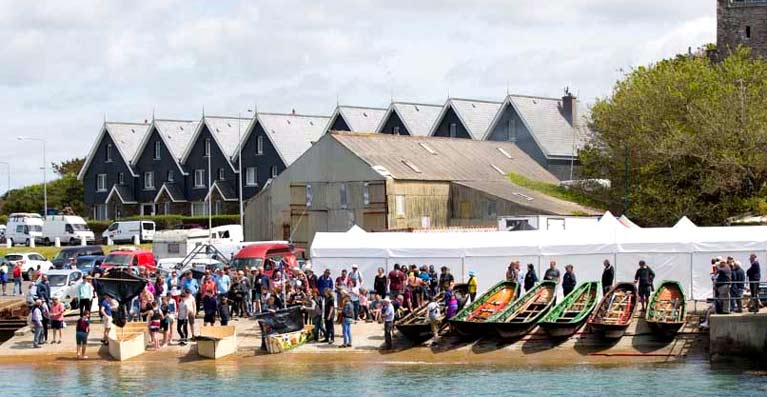 Getting ready to start the ‘New Boats’ race on Sunday, They were built on Saturday, with each team getting the same materials, including black plastic for sails. The boats have to row and sail a course if they stay afloat – it’s a highlight of the Festival The Meitheal Mara boats from Cork city are on the right. Photo: Robbie Murphy
Getting ready to start the ‘New Boats’ race on Sunday, They were built on Saturday, with each team getting the same materials, including black plastic for sails. The boats have to row and sail a course if they stay afloat – it’s a highlight of the Festival The Meitheal Mara boats from Cork city are on the right. Photo: Robbie Murphy
There was more for historic boat fans at today's Crosshaven Traditional Sail festival in Cork Harbour.
Afloat's Bob Bateman captured both the classic boat fleet and spectator craft (below) on another lovely afternoon at Crosshaven.
See day one Traditional Sail photos here and day two below.
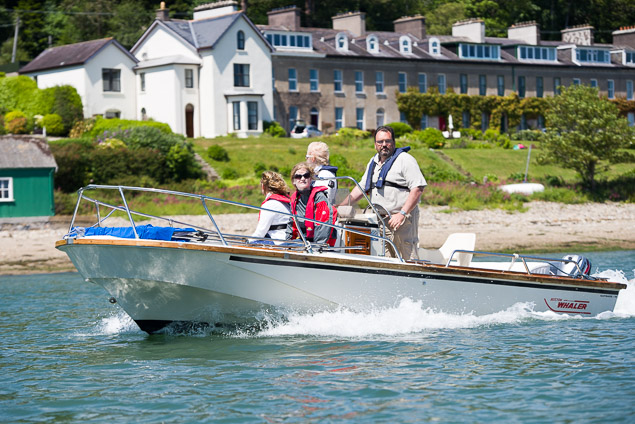
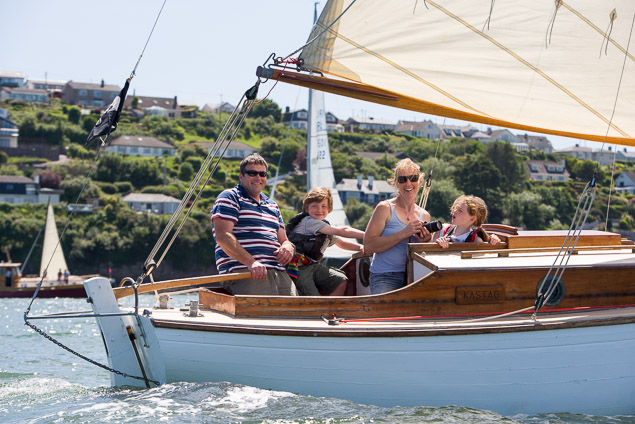
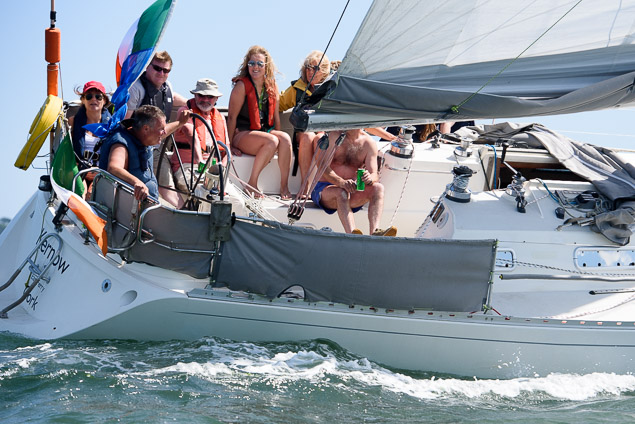
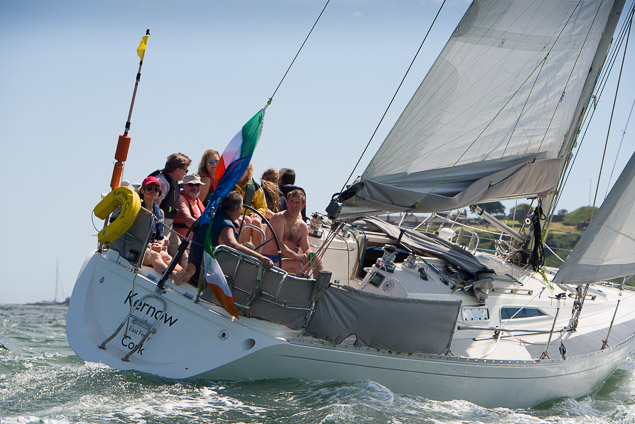
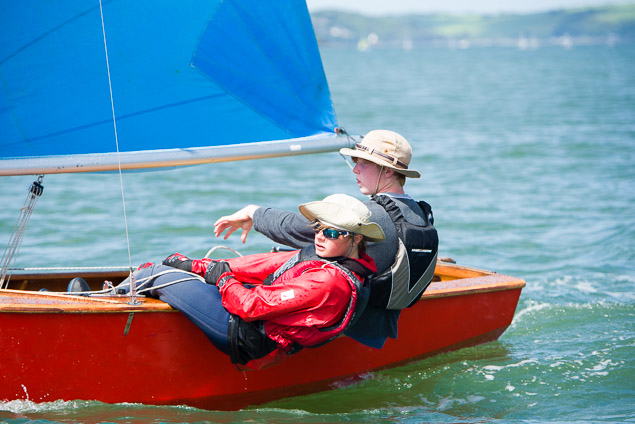
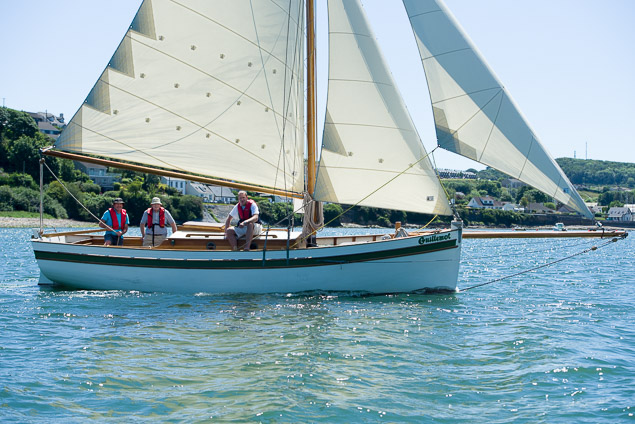



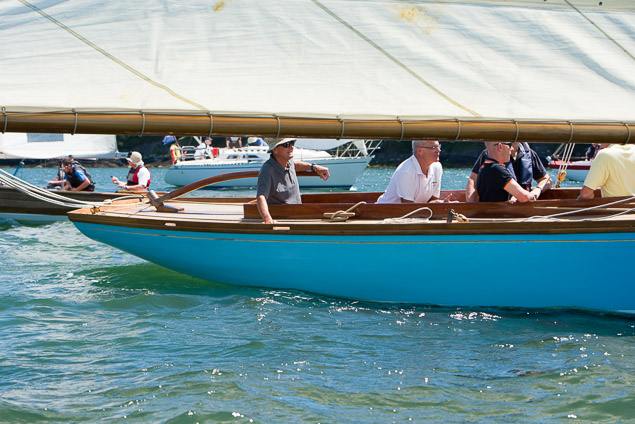
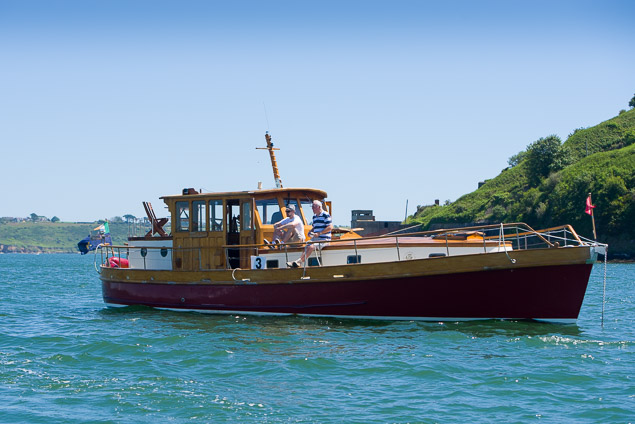
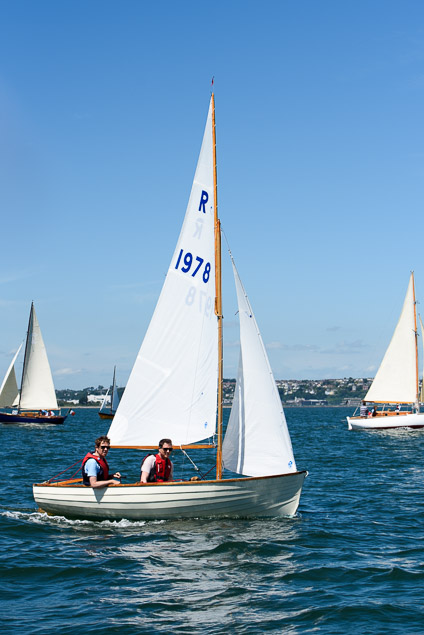
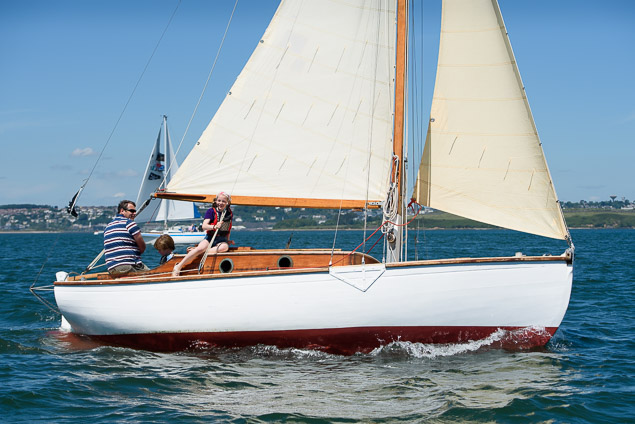
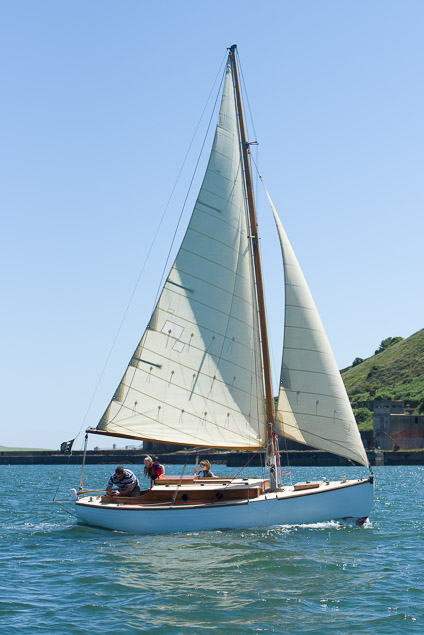



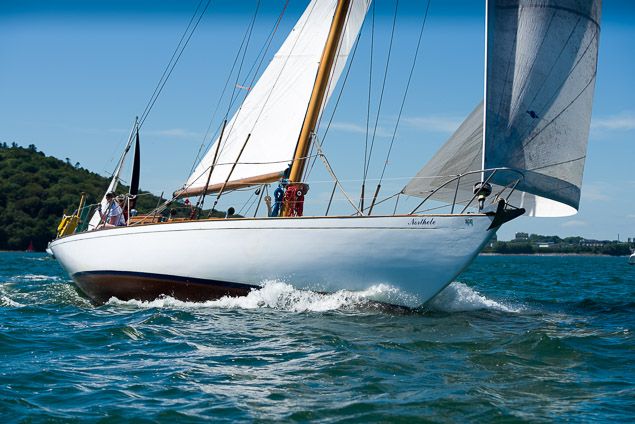
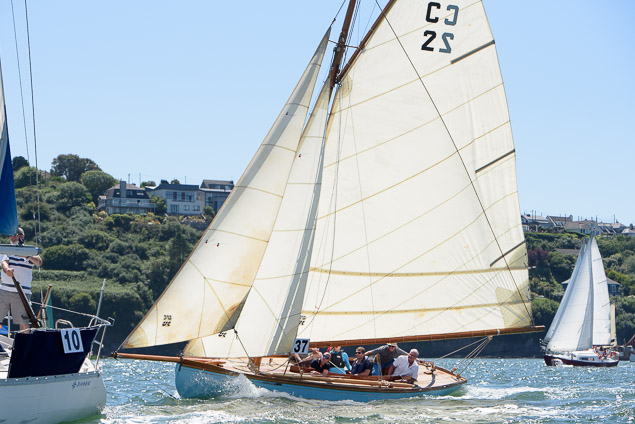
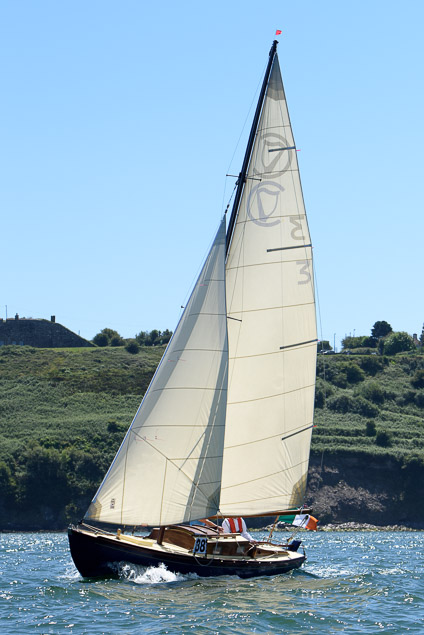



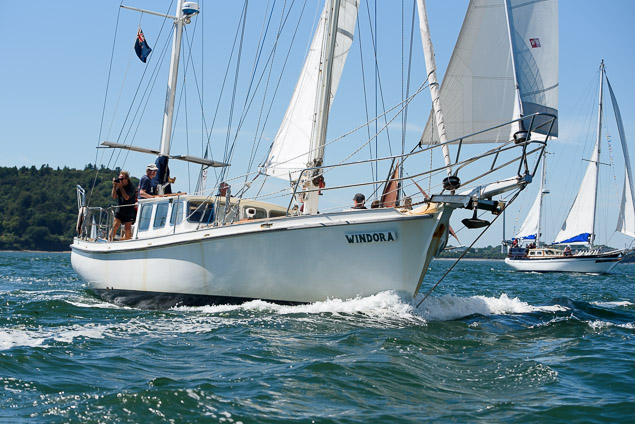
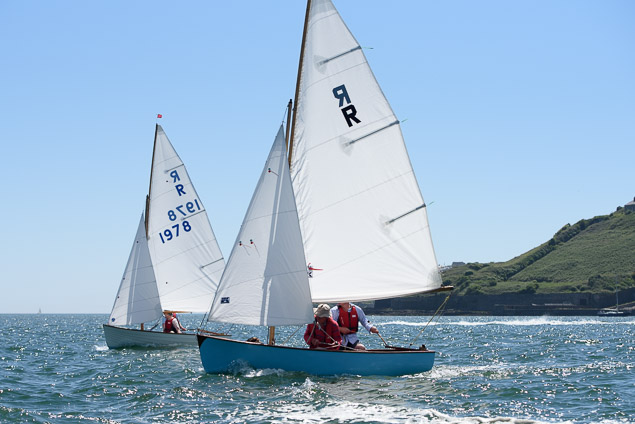
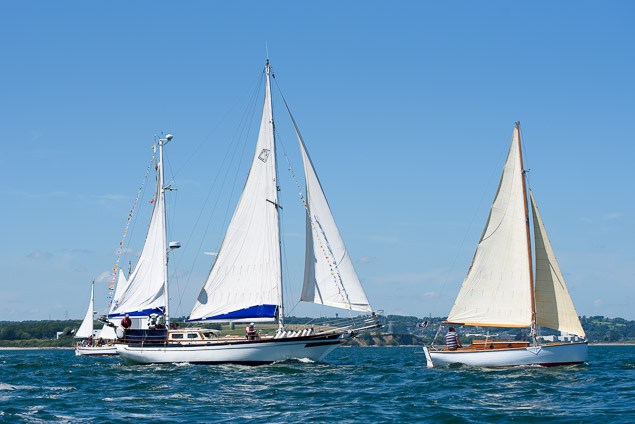



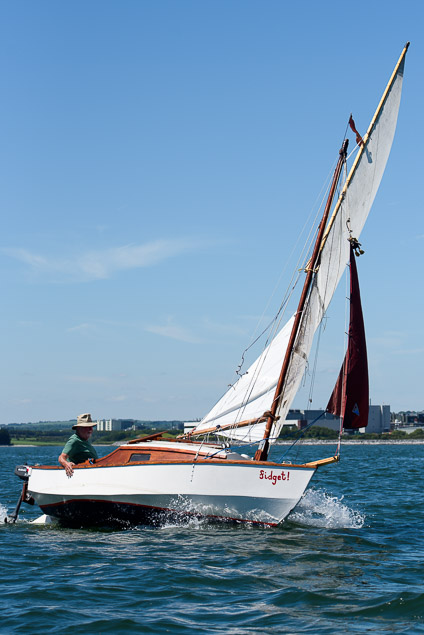
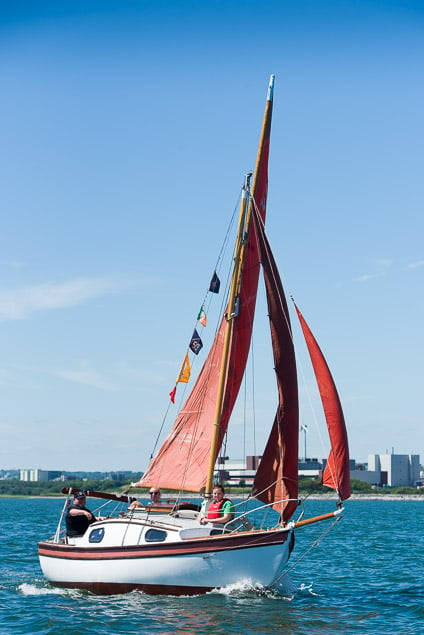
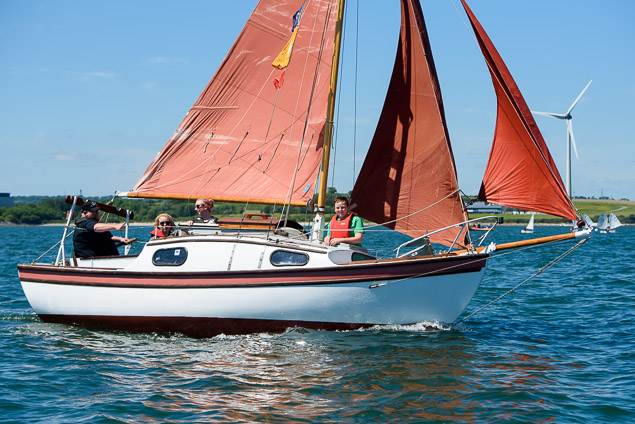
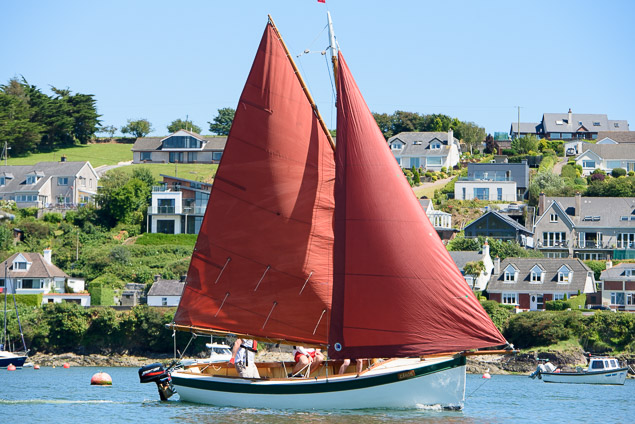
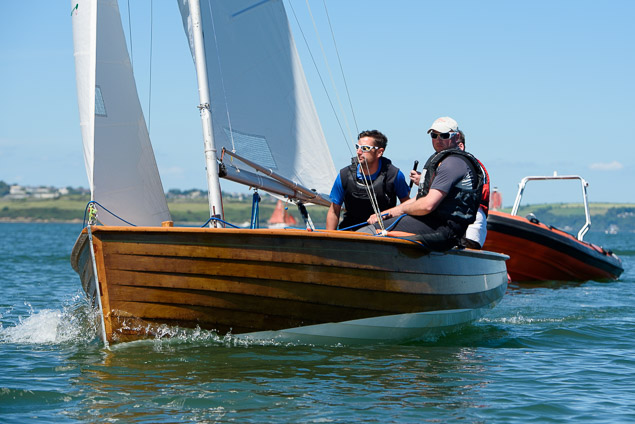
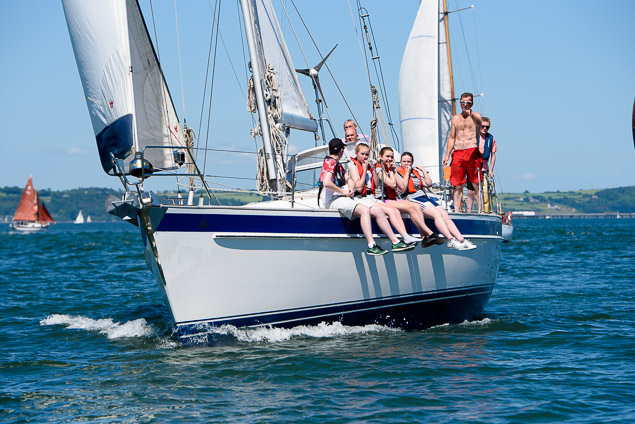
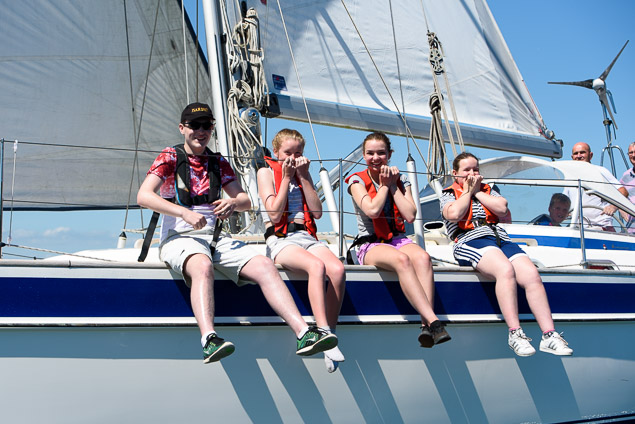
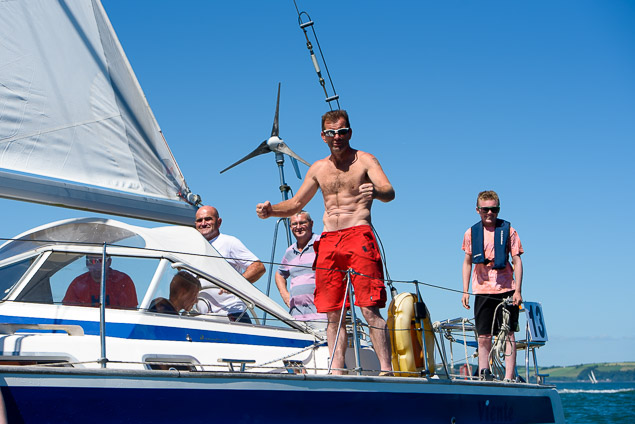
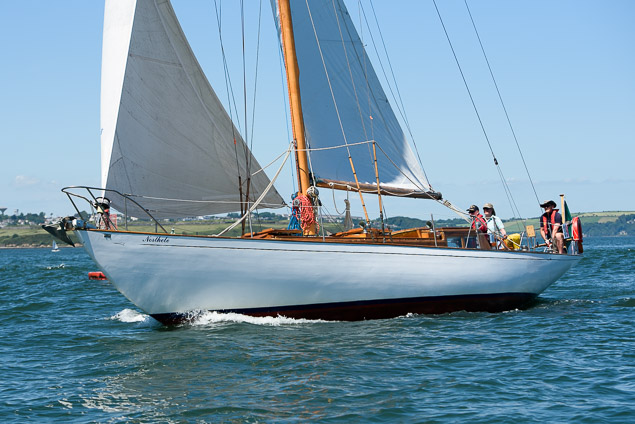


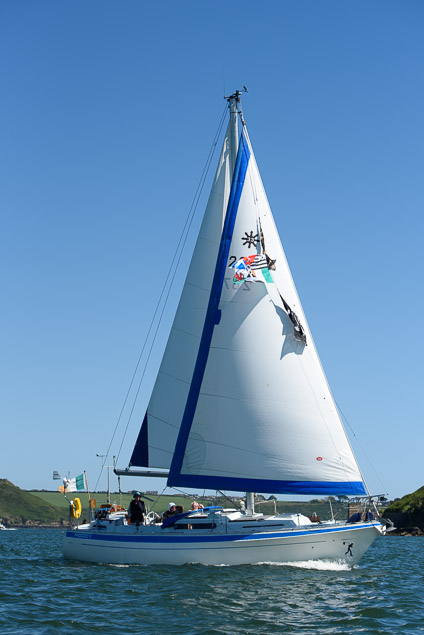


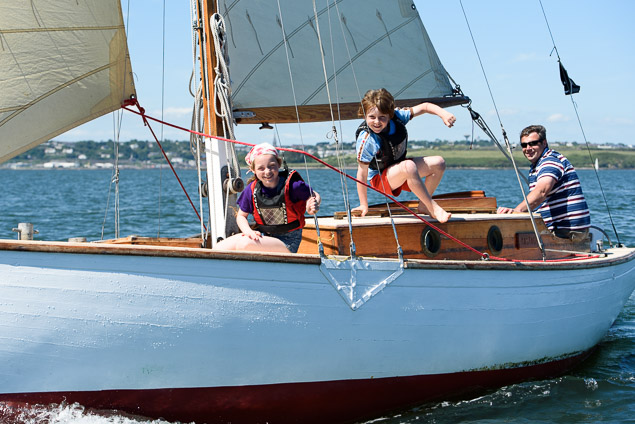
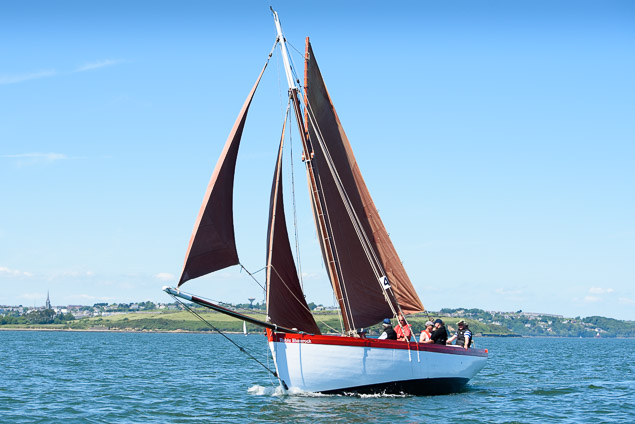
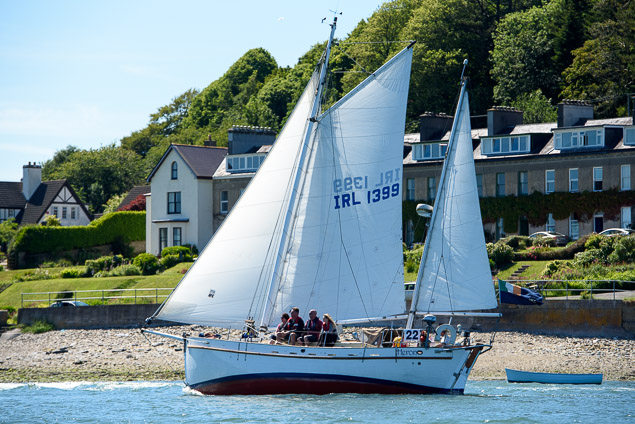
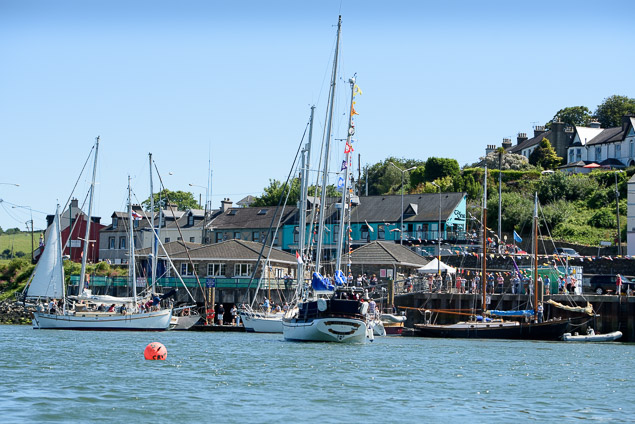
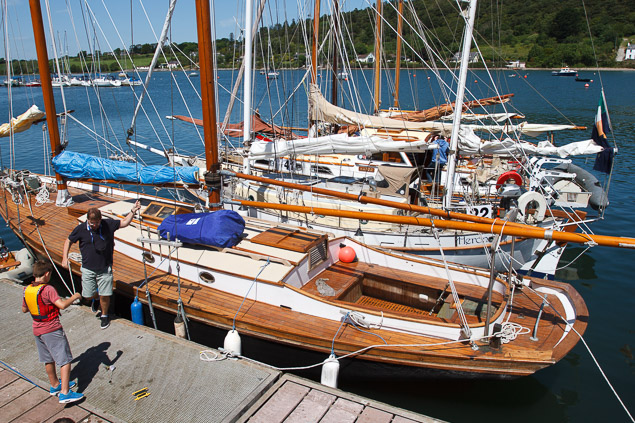

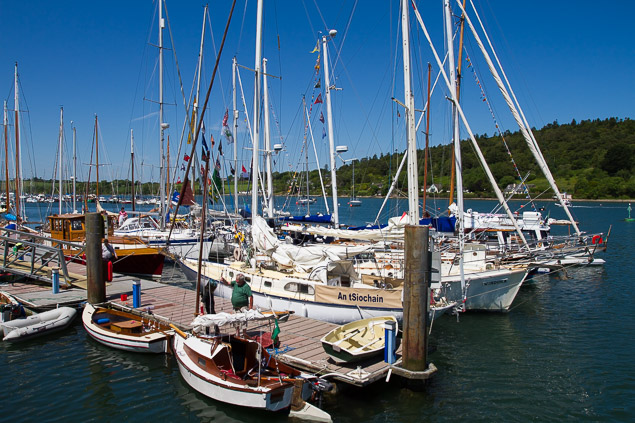
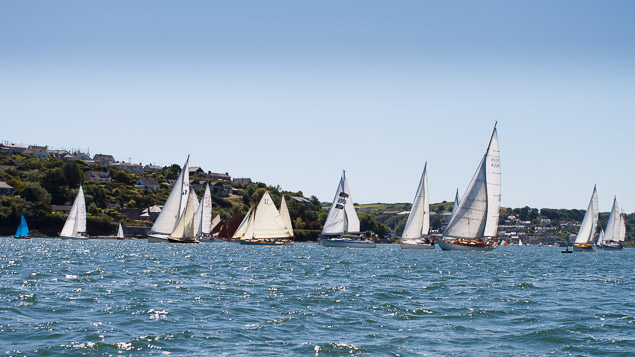
#STBFestival – The village of Portsoy in North-east Scotland is buzzing with excitement for the much anticipated return of the Aberdeen Asset Management Scottish Traditional Boat Festival on 22 and 23 June 2013, but long after the crowds have disappeared the festival's PORT project (Portsoy Organisation for Restoration and Training) hopes to leave its mark on the area for generations to come.
PORT was established by a group of volunteers including James Crombie, Pete Danks and Lorna Summers in 2005 with a view to preserving traditional boat building craft skills whilst also engaging young people with the important maritime heritage of the area. The project has since gone from strength to strength and shows no signs of slowing down.
James, Pete and their small team of volunteers initially set about teaching children the art of traditional boat building skills by launching the Faering Project. This focused on the Norwegian Faering, or 'four oar' boat as it is otherwise known – a boat with a simple design which is straight forward for youngsters to build, and which is the ancestor of our local types. The children who ventured on the first project have grown up with it and now, as teenagers, are involved in building much more complex designs.
James attributes the success of PORT largely to the volunteers. He adds, "We established this project eight years ago, and the success we have seen over the years has been unbelievable. We have a fantastic team of volunteers who work tirelessly to support the project and who will do anything for it.
"A major turning point for PORT arrived when we were gifted the Boatshed - a derelict harbourside building from which all training and restoration activities can take place - from the Portsoy Maritime Heritage Society. This development will allow us to expand our efforts and will mean that we can begin working on different types of boats, including the Optimist Dinghy, which is the world's most popular children's dinghy.
"The Boatshed will give us a spacious workshop which allows training and restoration to be undertaken in full view of the public. The renovation of the Boatshed is a £420,000 project funded by Aberdeenshire Council, CARS (a collaboration between Aberdeenshire council and Historic Scotland) and AEFF Axis 4 funding and will take place over the coming year.
"Also the architects Brown + Brown are generously donating their professional services as they are so supportive of our aims".
As well as providing an outlet for training and restoration, James hopes that the development of the Boatshed will move the project forward to become an attraction for visitors to the area. He adds, "The PORT Boatshed is one of the few of its kind in Scotland, and we hope that this will become a must-see attraction for tourists to the area. There is a real emphasis nowadays on tradition and local heritage, and I believe that visitors will be keen to learn about the traditional craft skills of our forefathers, as well as learning a few new skills along the way. These activities are a wonderful vehicle for teaching the skills needed in life for the 21st century".
Whilst the project was launched to educate young people on traditional craft skills, but in addition to craft skills, participants also learn basic geometry, interpersonal skills and teamwork.
The training programme takes participants from the initial stages of boat building right through to learning to sail the boats they have helped to create. James comments, "It is a real added bonus that our course participants are able to see all of their hard work come to fruition. Learning to sail - and eventually sailing the boats that they have put hard work into - that's something really special."
In order to advance the project, PORT bought a kit to build a St Ayles skiff – a traditional small boat. The skiff kit was purchased with the intention of teaching youngsters to build skiffs, however, in the end it was their mothers and grandmothers who took up the challenge. Following a visit to the Festival by the Scottish Coastal Rowing Project in 2011, a group of Portsoy 'quines' decided to learn the craft skills required to build a traditional skiff and based themselves at the PORT Boatshed. This led the ladies to establish a rowing team called the Portsoy Skiffettes on their own handmade boat, 'Soy Quine'.
The PORT team is on the brink of an ambitious project – they plan to build a full sized replica coble salmon fishing boat which is a completely different design to the other craft they have created to date. Whilst it is still a traditional boat, the coble is a much more sophisticated design and is more technically demanding to build.
Since its humble beginnings eight years ago, PORT has become an integral part of the Portsoy harbour and the Aberdeen Asset Management Scottish Traditional Boat Festival. Founded in 1993 as a community event to commemorate the 300th anniversary of the creation of the harbour, the Festival now puts a special emphasis on the preservation of craft skills, boat building, restoration and sailing, and on associated authentic skills such as knitting, weaving and embroidery.
This year the Festival is a key event in the Year of Natural Scotland – a partnership between the Scottish Government, VisitScotland, EventScotland and Scottish Natural Heritage which aims to showcase the country's unique natural environment.
For more information about the Festival and to buy tickets click here www.stbfportsoy.com.
Controlling The Canals
I wrote recently that the terms of Waterways Ireland's licence agreement for the "Extended Term Serviced Mooring Vacancies" at Shannon Harbour could be easily adapted for use elsewhere on the canals. That might allow WI to begin to bring the long-term berthers, residential or otherwise, under control. And so it proves. We have received this press release from Waterways Ireland.
WI Press Release
Waterways Ireland has recognised that many boat owners wish to stay for a more extended period in a single location than the 5 days the annual Canal Mooring and Passage Permit (under the Canals Act, 1986 (Bye-laws), 1988) currently allows.
In response, Waterways Ireland intends to issue an Extended Mooring Licence granting a boat owner the right to leave their boat in one location for longer than 5 days. This permit will enable the holder to moor in a position allocated by Waterways Ireland on a soft bank area of navigation property for a period of up to 1 year. The Extended Mooring Licence will cost e152 per annum.
The application process for the Extended Mooring Licence will open in the autumn when all existing permit holders will be contacted.
All boat owners will still require an annual Canal Mooring and Passage Permit allowing the holder to cruise and pass through locks. Boat owners with a Canal Mooring and Passage Permit proposing to stay longer in one location than 5 days can then apply for the Extended Mooring Licence. The total fee to hold both the Permit and the Licence in 2012/2013 will be e278.
For boat owners with the Canal Mooring and Passage Permit who do not hold an Extended Mooring Licence, the 5-day rule (in the one place or within 500m of that location) will still apply. Waterways Ireland will enforce this bye-law from autumn 2012.
Waterways Ireland will be contacting permit holders regularly between now and autumn 2012 to ensure they are kept up to date with the roll-out of the new permit. All queries about the enforcement of the current bye-laws or the Extended Mooring Licence should be directed to Shane Anderson, Assistant Inspector of Navigation: Tel no +353 (0)87 286 5726, Email [email protected].
These changes are necessary steps to improve the management of the canals and waterway amenities for both the navigational and recreational user, so that investment in the new infrastructure and facilities which Waterways Ireland has undertaken is maximised for every user.
Comment
About time too. I welcome this development: WI has to be able to control who uses its waterways and the uses they make of them.
The proposed charge is surprisingly modest. It is the same for all areas, those of high and of low demand: it might have been difficult to implement differential charging. However, the new licence does not apply to hard-edged areas; I presume therefore that WI intends to keep them clear for visitors.
It is significant that the new control mechanism is a licence, not a permit. Waterways Ireland had been hoping to bring in a single set of bye-laws to cover all its navigations, but it proved to be very difficult to do that within two jurisdictions. Accordingly, I understand that WI now intends to seek amendments to the bye-laws for the Republic, allowing it (inter alia) to increase the charges for various permits. However, the Canals Act 1986 allows WI to issue licences, and they are not subject to the restrictions in the bye-laws.
Royal water
The fragility of the water supply to the Royal Canal was shown in April, when Waterways Ireland closed the summit level of the canal because of low water levels; the 34th and 35th levels were also closed for emergency repairs. At time of writing, WI is hoping to be able to re-open the summit level on 1 June. Some boats that had intended to go west along the Royal to the Shannon were forced to go east instead, through Dublin and along the Grand Canal; happily, Effin Bridge, the lifting bridge at North Strand Road, worked properly this year.
The Royal always had fewer feeders than the Grand. The summit level was fed from Lough Owel, north of Mullingar, but while the canal was closed, Westmeath County Council found it needed more drinking water for the Mullingar area. In dry conditions, the Lough Owel feeder cannot meet both needs.
With great foresight, CIE (which then owned the canal) got the Council to agree that, if the canal was to be re-opened, it would provide an alternative supply.
Nowadays, environmental regulations mean that water abstraction needs more thought, more planning and more factors to be considered. Extensive studies were carried out and WI and the County Council agreed that the best possible alternative source was Lough Ennell, which is south of Mullingar: water could be pumped from there to the canal. The Council had to apply to An Bord Pleanála for permission; it has just completed oral hearings in Mullingar.
Traditional boats
In the first half of the nineteenth century, anyone travelling to the seaside resort of Kilkee could take the steamer to Kilrush and travel onward by road. But the passenger traffic was initially established by the turf boats of the Shannon Estuary: most of Limerick's fuel came from Poulnasherry, west of Kilrush, and was carried by small sailing boats, which also carried a few passengers.
A 24' replica of one of these boats was launched recently at Querrin, at the entrance to Poulnasherry. The Sally O'Keeffe was built by the Seol Sionna group http://seolsionna.org/, which grew out of the West Clare Currach Club. The boat will be used for sailing training. The Shannon Estuary, which is insufficiently appreciated, has a wealth of traditional boat types, but there were no extant Shannon hookers, so it is nice to see their return.
On the same weekend, another of those traditional boat types was featured in Limerick. The Ilen Wooden Boat Building School http://ilen.ie/gandelow-races/ had built five gandelows, boats used in the upper reaches of the estuary, and conducted races in the city.
And the Thomastown Regatta, on the Nore http://www.happyvalleyfestival.com/ebooklet.pdf, will feature traditional cots and racing boats: the 1905 racing cot Nore Lass, owned by the O'Farrell family, will be on display at the Grennan Mill Craft School.
Here are some updates I wrote about recently...
Water charges
The EU Commission sent a Reasoned Opinion to Ireland in November 2011, suggesting that Ireland had not correctly implemented the provisions of the Water Framework Directive that require "a cost recovery policy for water services that includes the environmental and resource costs of water use". The Commission believes that cost recovery should be extended to many other water uses, including hydroelectricity generation and the supply of water to navigations. Having got an extension of the deadline for replying, the Department of the Environment, Community and Local Government responded to the Commission. I asked for a copy of the response, but the department won't tell anybody what it's doing. I am appealing that decision, but without much hope.
Traffic
Waterways Ireland has kindly given me the Shannon traffic figures for the first four months of 2012. The numbers of movements in those months are always low, and can be significantly affected by the weather, so there can be quite a lot of variation between one year and another without its indicating any long-term trend. For example, back in 2002, there were 4875 boat movements in the first four months; the figure was up to 6204 in 2003 but back down to 5304 in 2004. It's important therefore not to read too much into the figures, but a five-year moving average suggests that traffic has been falling since 2007. The figure for 2012 was 4052. It will be interesting to see whether better weather balances economic gloom in the rest of the year.
Mineral Oil Tax
In the last issue, I gave the figures for the numbers of Mineral Oil Tax returns received by Revenue from owners of diesel-powered boats in the first two years of the scheme's operation. They told me that they got 38 returns in 2010 for the year 2009 and 41 in 2011 for 2010. I now have the figure for the following year, the returns made in 2012 for the year 2011. There was a very significant change, of 46%, but unfortunately it was downward, to 22. The Revenue Commissioners tell me that "[...] there were 22 returns received by 1 March 2012 for 2011, amounting to e53,398.58 MOT [Mineral Oil Tax] on 141,503.29 litres oil." That's an average of 6432.1 litres each, which is a lot, so I suspect that much of the total came from the hire fleet, with less than twenty private owners making returns.
Royal and Ulster Canals
I said, in the last issue, that I did not understand how the cost of the restoration of the Royal Canal, 146 km with 46 locks, could be less than the expected cost of the canal to Clones, 13 km with one double lock. It has been explained to me that the figure for the Royal was essentially only the marginal cost, recorded (initially) under Civil Service accounting procedures, so that it understates the total cost. It would be a huge job to try to find the full cost using modern accounting conventions, but unfortunately that means that we have no usable figure for the cost of the Royal, no basis for estimating the return on investment and no guideline on the value of any future restorations.



























